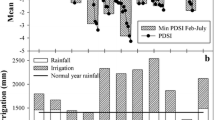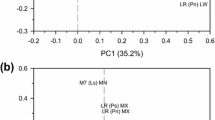Abstract
Three different methods were evaluated for analysing wood formation of Norway spruce [Picea abies (L.) Karst.] and Scots pine (Pinus sylvestris L.) in Finland. During two growing seasons, wood formation dynamics were determined both by wounding the cambium with a needle followed by localisation of the wound-associated tissue modification after the growing season (pinning), and by extracting small increment cores during the growing season (microcoring). Stem radius was additionally monitored with band dendrometers. For Norway spruce, pinning and microcoring yielded similar dates for the onset of wood formation. The timing of wood production during the growing season was also similar for pinning and microcoring. For Scots pine, the onset of wood formation was recorded from microcores almost 2 weeks later than from pinning samples. In Scots pine, microcore measurements also produced somewhat later cessation dates for tracheid formation than the pinning samples. For both tree species, the total number of tracheids formed during the growing season was, however, about the same for pinning and microcoring. Dendrometer results clearly differed from those of pinning and microcoring. In particular, the dendrometers showed an increase of stem radius considerably earlier in spring, when the other methods did not detect wood formation. Thus, pinning and microcoring currently represent the most reliable techniques for detailed monitoring of wood formation.






Similar content being viewed by others
References
Antonova G, Stasova V (1993) Effects of environmental factors on wood formation in Scots pine stems. Trees 7:214–219
Bäucker E, Bues C-T, Vogel M (1998) Radial growth dynamics of spruce (Picea abies) measured by micro-cores. IAWA J 19:301–309
Brix H, Mitchell K (1980) Effects of thinning and nitrogen fertilization on xylem development in Douglas-fir. Can J For Res 10:121–128
Cajander AK (1949) Forest types and their significance. Acta For Fenn 56:1–71
Creber GT, Chaloner WO (1984) Influence of environmental factors on the wood structure of living and fossil trees. Bot Rev 50:357–448
Deslauriers A, Morin H (2005) Intra-annual tracheid production in balsam fir stems and the effect of meteorological variables. Trees 19:402–408
Deslauriers A, Morin H, Begin Y (2003a) Cellular phenology of annual ring formation of Abies balsamea in the Quebec boreal forest (Canada). Can J For Res 33:190–200
Deslauriers A, Morin H, Urbinati C, Carrer M (2003b) Daily weather response of balsam fir (Abies balsamea (L.) Mill.) stem radius increment from dendrometer analysis in the boreal forests of Québec (Canada). Trees 17:477–484
Downes G, Beadle C, Worledge D (1999) Daily stem growth patterns in irrigated Eucalyptus globulus and E. nitens in relation to climate. Trees 14:102–111
Dünisch O, Bauch J, Gasparotto L (2002) Formation of increment zones and intraannual growth dynamics in the xylem of Swietenia macrophylla, Carapa guianensis, and Cedrela odorata (Meliaceae). IAWA J 23:101–119
Forster T, Schweingruber HF, Denneler B (2000) Increment puncher. A tool for extracting small cores of wood and bark from living trees. IAWA J 21:169–180
Herzog KM, Häsler R, Thum R (1995) Diurnal changes in the radius of a subalpine Norway spruce stem: their relation to sap flow and their use to estimate transpiration. Trees 10:94–101
Hunt R (1982) Plant growth curves: the functional approach to plant growth analysis. Edward Arnold, London
Kozlowski TT, Winget CH (1964) Diurnal and seasonal variations in radii of tree stems. Ecology 45:149–155
Kuroda K (1986) Wound effects on cytodifferentation in the secondary xylem of woody plants. Wood Res 72:67–117
Kuroda K, Kiyono Y (1997) Seasonal rhythms of xylem growth measured by the wounding method and with a band-dendrometer: an instance of Chamaecyparis obtusa. IAWA J 18:291–299
Liese W, Dadswell HE (1959) Űber den Einfluß der Himmelsrichtung auf die Länge von Holzfäsern unf Tracheiden. Holz Roh Werkst 17:421–427
Loris K (1981) Dickenwachstum von Zirbe, Fichte, und Lärche an der alpinen Waldgrenze/Patscherkofel. Ergebnisse der Dendrometermessungen 1976/79. Mitteilungen der forstlichen Bundesversuchsanstalt. Wien 142:417–441
Mahmood A (1971) Number of initial-cell divisions as a measure of activity in the yearly cambial growth pattern in Pinus. Pak J For 21:27–42
Mäkinen H, Nöjd P, Saranpää P (2003) Seasonal changes in stem radius and production of new tracheids in Norway spruce. Tree Physiol 23:959–968
Nobuchi T, Ogata Y, Siripatanadilok S (1995) Seasonal characteristiis of wood formation in Hopea odorata and Shorea henryana. IAWA J 16:361–369
Nöjd P, Henttonen H, Mäkinen H (2008) Increment cores from the Finnish national forest inventory as a source of information for studying intra-annual wood formation. Dendrochronologia (in press)
Ohashi Y, Sahri MH, Yoshizawa N, Itoh T (2001) Annual rhythm of xylem growth in rubberwood (Hevea brasiliensis) trees grown in Malaysia. Holzforschung 55:151–154
Pesonen E, Mielikäinen K, Mäkinen H (2004) A new girth band for measuring stem diameter changes. Forestry 77:431–439
Rossi S, Deslauriers A, Anfodillo T, Morin H, Saracino A, Motta R, Borghetti M (2006a) Conifers in cold environments synchronize maximum growth rate of tree-ring formation with day length. New Phytol 170:301–310
Rossi S, Anfodillo T, Menardi R (2006b) Trephor: a new tool for sampling microcores from tree stems. IAWA J 27:89–97
SAS Institute Inc. (2004) SAS/STAT® User’s Guide. Cary, NC, USA
Sass U, Killmann W, Eckstein D (1995) Wood formation in two species of Dipterocarpaceae in Peninsular Malaysia. IAWA J 16:371–384
Savidge RA (1996) Xylogenesis, genetic and environmental regulation (review). IAWA J 17:269–310
Schmitt U, Möller R, Eckstein D (2000) Seasonal wood formation dynamics of beech (Fagus sylvatica L.) and black locust (Robinia pseudoacacia L.) as determined by the “pinning” technique. J Appl Bot 74:10–16
Schmitt U, Jalkanen R, Eckstein D (2004) Cambium dynamics of Pinus sylvestris and Betula spp. in the northern boreal forest in Finland. Silva Fenn 38:167–178
Seo J-W, Eckstein D, Schmitt U (2007) The pinning method—from pinning to data preparation. Dendrochronologia 25:79–86
Shiokura T (1989) A method to measure radial increment in tropical trees. IAWA Bull 10:147–154
Tardif J, Flannigan M, Bergeron Y (2001) An analysis of the daily radial activity of 7 boreal tree species, northwestern Quebec. Environ Monit Assess 67:141–160
Vogel M (1995) Estimation of increment stairs step curves from values of radial increment measurements. Allg Forst- u J-Ztg 166:211–215
Wodzicki TJ (1971) Mechanism of xylem differentiation in Pinus silvestris L. J Exp Bot 22:670–687
Wolter KE (1968) A new method for marking xylem growth. For Sci 14:102–104
Worbes M (1995) How to measure growth dynamics in tropical trees: a review. IAWA J 16:337–351
Yamashita K, Okada N, Kamo K (2006) Application of the wire dendrometer for monitoring the radial growth of trees: a comparison with the conventional band dendrometer and the pinning method (in Japanese with English abstract and legends). Mokuzai Gakkaishi 52:8–18
Yoda K, Suzuki M, Suzuki H (2000) Development and evaluation of a new type of opto-electronic dendrometer. IAWA J 21:425–434
Yoshimura K, Hayashi S, Itoh T, Shimaji K (1981) Studies on the improvement of the pinning method for marking xylem growth. I. Minute examination of pin marks in taeda pine and other species. Wood Res 67:1–16
Źumer M (1969) Annual ring formation on Norway spruce in mountain forest. Reports of the Norwegian Forest Research Institute 97, XXVII 2:161–184 (in Norwegian with English summary)
Zweifel R, Häsler R (2000) Frost-induced reversible shrinkage of bark of mature subalpine conifers. Agric For Meteorol 102:213–222
Zweifel R, Item H, Häsler R (2001) Link between diurnal stem radius changes and tree water relations. Tree Physiol 21:869–877
Acknowledgments
We are greatly indebted to Tarmo Aalto, Tapio Huttunen, Laura Kärki and Tanja Potsch for their skilful technical assistance, and the staff of the Kivalo research area for their careful field sampling.
Author information
Authors and Affiliations
Corresponding author
Additional information
Communicated by Rainer Matyssek.
Rights and permissions
About this article
Cite this article
Mäkinen, H., Seo, JW., Nöjd, P. et al. Seasonal dynamics of wood formation: a comparison between pinning, microcoring and dendrometer measurements. Eur J Forest Res 127, 235–245 (2008). https://doi.org/10.1007/s10342-007-0199-x
Received:
Revised:
Accepted:
Published:
Issue Date:
DOI: https://doi.org/10.1007/s10342-007-0199-x




